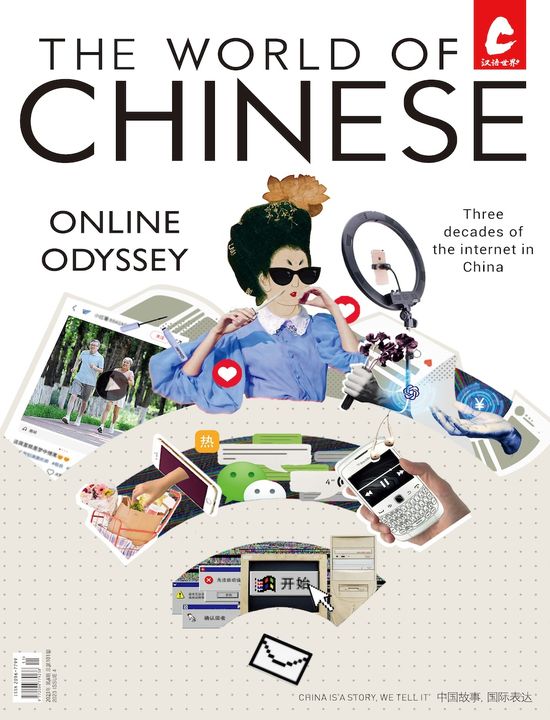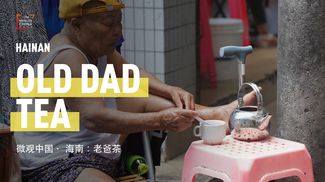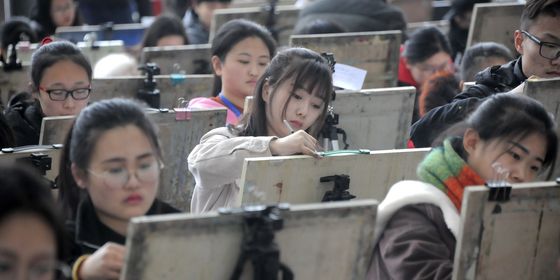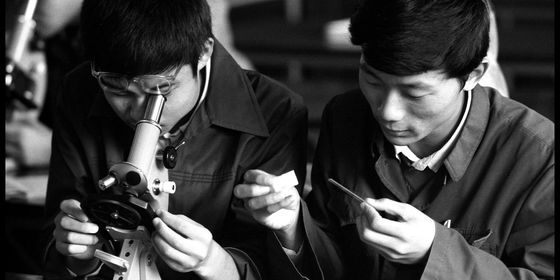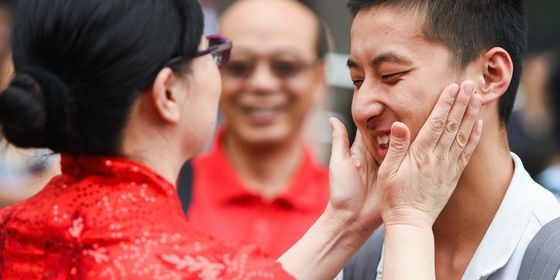Should rural youths pursue places at vocational schools instead of universities?
The story of Wang Xinyi took Chinese social media by storm, after the 18-year old from Hebei province posted a viral essay on Weibo titled “Thank You Poverty,” which was picked up by numerous regional and national media outlets.
Wang scored 707 out of 750 points in this year’s gaokao to win a place in Peking University’s (PKU or “Beida”) prestigious Department of Chinese Language.
But despite the romantic appeal of such stories, statistics show that rags-to-possible-riches tales like Wang’s are becoming ever rarer. Until last year, when the government introduced a quota rule, the proportion of students from rural households was annually decreasing at both PKU and its rival Tsinghua University, China’s two top-ranked institutions, with a China News report observing an overall decrease of 20 percent between 1993 and 2013.
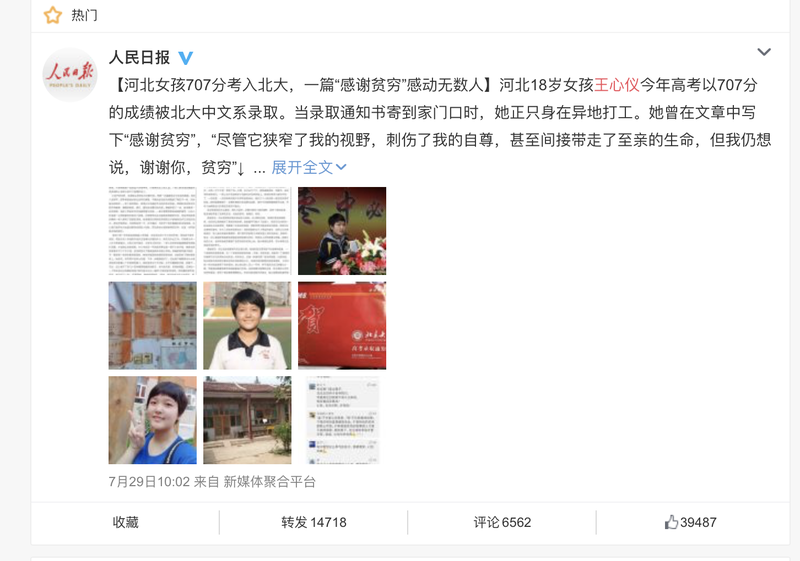
A collage of numerous media reports on Wang Xinyi, July 29 (image via People’s Daily Weibo)
However, Wang Shuguang, economics professor at PKU, says that trying to change the gaokao‘s rules misses the bigger picture. For Chinese youth from low-income households, especially those who may not have had Wang Xinyi’s combination of talent, hard work, and (probably) luck, the gaokao—and secondary education in general—are not as attractive as they once were. “I am not in the least interested in the rules of the examination itself,” Dr. Wang tells TWOC. “Its most controversial characteristics are only the symptom of a wider problem: the narrow range of post-secondary school options.”
Dr. Wang is one of the leading experts on economic development in rural China. Few understand more than him the importance in which the gaokao is held: Hailing from a small village in the Shandong countryside, the exam was his only escape from a life of rural hardship. He was admitted into PKU in 1990, and his subsequent achievements fed into the classic success story for village people: That the gaokao is the only chance for poor Chinese students to “change their destiny” (改变他的命运), a phrase often used in defense of the ancient examination system.
According to Wang, however, the original egalitarian premises upon which the gaokao was instituted no longer apply. During the 1980s and early 90s, when under half of all test-takers were admitted to universities, and simply getting in was a feat in the eyes of poor families and employers, the gaokao was a relatively reliable tool of social mobility. Today, though, admission rates among youths have exceed 80 percent, and a degree is by no means a guarantee that students from a low socioeconomic background will gain the skills or reputation they need to impress employers.
Indeed, a 2013 paper written by Northeast Normal University researcher Zhao Yajing highlights an increasing number of students from rural households who, after graduating from second and third-tier universities, are unable to find a suitable job in the city, and are left with no choice but to return home. This has led to an increasing belief amongst many rural households that, if the son or daughter is not a Wang Xin Yi-type student, sending them to university is a poor investment. Zhao observes that this has been driving a slow, but steady, increase in the number of high-school students from rural households who are deciding to forfeit the gaokao.
This is precisely why scholars like Wang Shuguang believe resources and attention have to be shifted away from the gaokao and into another educational institution: vocational schools (职业学校).
“China lacks workers with a ‘craftsman’s spirit’ (gōngjiàng jīngshén, 工匠精神),” Dr. Wang claims. “We need people that can build beautiful pipelines, someone who can make clothes, open small stores, do entrepreneurial things. This is the future for the Chinese in the middle and lower social classes, especially the farmers,” he argues, citing Germany’s elite vocational education system as a model.
However, there are many socio-cultural and institutional barriers to Wang’s plan. In 2013, a report by the National Center on Education and Economy suggested that one of the biggest challenges facing China’s vocational training system was their low status in the public’s opinion.
Another is the continued admiration of prestigious universities in Chinese households, a consequence of the social status entering such an institution confers.
“From the moment my little brother and I were born, my father made the names ‘Beida’ and ‘Tsinghua,’ sacred in our house,” 25 year-old Shao Xin, who grew up in rural Shanxi province, told TWOC. Shao eventually graduated with a Master’s degree in electrical engineering from PKU.
Ge Xizheng (葛煕正), an 18-year-old from a middle-class urban household in Zhengzhou, Henan province, agrees. “It’s been inculcated in me since a young age that I should aim for a first-tier university,” says Ge, who took the gaokao this year. “Even though I don’t know what I want to do in the future, just being in a first-tier university will have better influence on me than going to a vocational college. People carry themselves differently, both in speech and manner.”
Some reports suggest, however, that the quality of teaching in Chinese universities has been declining. Overly-theoretical courses with little relation to the job market are cited as one of the main issues. According to Wang, even technical degrees at universities fail to provide hands-on skills that instil youths with that “craftsman’s spirit.” The NCEE reported that the majority of China’s vocational schools’ curriculums were “outdated and irrelevant to the needs of the industry.”
In Beijing, though, one vocational institute has earned nationwide recognition for addressing these issues. The origins of the privately-run Bailie University (培黎职业学院) are unconventional, certainly by Chinese standards. It was founded in 1983 by one of CCP’s most famous foreign supporters, New Zealander Rewi Alley, and named after Alley’s friend, Joseph Bailie, who was credited with initiating an education movement in China that emphasized integrating theory with practice.
‘We occupy the middle ground between the traditional vocational schools that only teach their students one skill and universities like Beida and Qinghua,” says Peili headmaster Wang Yulin (王余临). Last year, President Xi Jinping wrote a formal letter to the school, praising it for its track record in creating highly-skilled workers, something that the state has been pushing in its own policy initiatives such as “Made in China 2025.”
According to Wang Yulin, ensuring every degree has tight connections to industry is Peili’s main priority, and it has maintained a graduate employment rate of over 95 percent for the past decade. Most importantly, the quality of employment obtained by Peili’s students has begun to reach that of graduates from Beida and Tsinghua. One computer science teacher, who wished to remain unnamed, observed proudly that she had students who got jobs right after graduation, where they made RMB 16,000 to 19,000 a month. Peili students also go to top universities to audit lectures and attend campus recruiting events.
“There was a time when we tried to strive for the academic reputation of [Beida and Tsinghua], but then we realized this was impossible, which forced us to become more pragmatic with regards to our student’s abilities and find a middle ground,” Wang Yulin says. “After all, there aren’t that many government jobs, so we had to make sure our students would be able to succeed in other, more practical positions.”
Yet the jury is still out on whether good vocational schools can be created outside of Beijing and Shanghai.
“Nowadays, there are farmers who would like their children to study something useful, but the problem is that they can’t find the schools,’ said Wang Shuguang. ‘The government creates 5 to 10 day programs that provide basic training on technical skills such as using a computer, but the cost of these is incomparable to that of building a vocational institute. It’s cheaper than a university, but funds outside Beijing and Shanghai are still scarce for such projects.”
Rather, Dr. Wang believes, billionaire entrepreneurs like Jack Ma could take a greater role in funding the development of vocational schools in China’s rural areas, which could eventually help the country transition from a low-skilled, export-led economy to the high-skilled, innovation society. But until that happens, the majority of rural households will continue to pin their hopes on the gaokao system and stories like that of Wang Xinyi.
“Thanks to the gaokao, my parents can soon stop growing sweet potatoes for a living; I doubt vocational school could have done the same for me. Only by being in Beijing could I get a high-paying job,” argues Shao, who will start his new position in Huawei this week as a tech researcher, earning over 50,000 RMB per month. “It took two tries for me to get into Beida, but it was worth it.”
